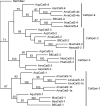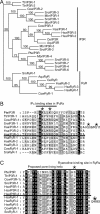Ancestral Ca2+ signaling machinery in early animal and fungal evolution
- PMID: 21680871
- PMCID: PMC4037924
- DOI: 10.1093/molbev/msr149
Ancestral Ca2+ signaling machinery in early animal and fungal evolution
Abstract
Animals and fungi diverged from a common unicellular ancestor of Opisthokonta, yet they exhibit significant differences in their components of Ca2+ signaling pathways. Many Ca2+ signaling molecules appear to be either animal-specific or fungal-specific, which is generally believed to result from lineage-specific adaptations to distinct physiological requirements. Here, by analyzing the genomic data from several close relatives of animals and fungi, we demonstrate that many components of animal and fungal Ca2+ signaling machineries are present in the apusozoan protist Thecamonas trahens, which belongs to the putative unicellular sister group to Opisthokonta. We also identify the conserved portion of Ca2+ signaling molecules in early evolution of animals and fungi following their divergence. Furthermore, our results reveal the lineage-specific expansion of Ca2+ channels and transporters in the unicellular ancestors of animals and in basal fungi. These findings provide novel insights into the evolution and regulation of Ca2+ signaling critical for animal and fungal biology.
Figures





References
-
- Axelsen KB, Palmgren MG. Evolution of substrate specificities in the P-type ATPase superfamily. J Mol Evol. 1998;46:84–101. - PubMed
-
- Bencina M, Bagar T, Lah L, Krasevec N. A comparative genomic analysis of calcium and proton signaling/homeostasis in Aspergillus species. Fungal Genet Biol. 2009;46(Suppl 1):S93–S104. - PubMed
-
- Berridge MJ. Inositol trisphosphate and calcium signalling mechanisms. Biochim Biophys Acta. 2009;1793:933–940. - PubMed
-
- Berridge MJ, Bootman MD, Roderick HL. Calcium signalling: dynamics, homeostasis and remodelling. Nat Rev Mol Cell Biol. 2003;4:517–529. - PubMed
MeSH terms
Substances
Grants and funding
LinkOut - more resources
Full Text Sources
Medical
Miscellaneous

